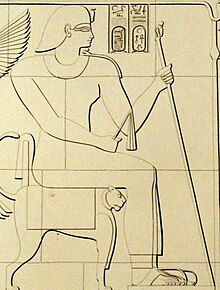Amanislo
Appearance
| Amanislo | ||||||||||||||||||||||||||||||||||||||||||||||||||
|---|---|---|---|---|---|---|---|---|---|---|---|---|---|---|---|---|---|---|---|---|---|---|---|---|---|---|---|---|---|---|---|---|---|---|---|---|---|---|---|---|---|---|---|---|---|---|---|---|---|---|
 Amanislo as depicted in his tomb (Beg. S 5) | ||||||||||||||||||||||||||||||||||||||||||||||||||
| Pharaoh | ||||||||||||||||||||||||||||||||||||||||||||||||||
| Reign | Middle 3rd century BCE | |||||||||||||||||||||||||||||||||||||||||||||||||
| Predecessor | Arakamani | |||||||||||||||||||||||||||||||||||||||||||||||||
| Successor | Amantekha | |||||||||||||||||||||||||||||||||||||||||||||||||
| ||||||||||||||||||||||||||||||||||||||||||||||||||
| Burial | Meroe, Beg. S 5 | |||||||||||||||||||||||||||||||||||||||||||||||||
Amanislo was a king of Kush dating to the middle of the third century BCE.[1]
Monuments and inscriptions
[edit]
Amanislo is mainly known from his pyramid at Meroë. He is buried in Meroe, Beg. S 5. From the position of his pyramid it has been argued that he was the successor of king Arakamani and the predecessor of Amantekha.[1][2]
He is also known from an inscription on granite lion figures, the Prudhoe Lions, originally belonging to the Egyptian pharaoh Amenhotep III and now at the British Museum. There is also a column drum, found at Semna perhaps providing his name, although the reading is uncertain.
In modern culture
[edit]Amanislo appears as Amonasro, King of Ethiopia in Verdi's Aida, following the scenario written by Auguste Mariette.
References
[edit]Literature
[edit]- Laszlo Török, in: Fontes Historiae Nubiorum, Vol. II, Bergen 1996, p. 568-569, ISBN 82-91626-01-4

